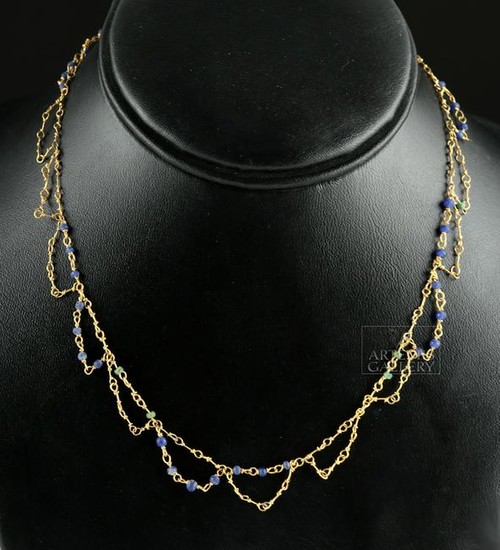Greek Hellenistic 23K+ Gold & Glass Bead Necklace
Greece, Hellenistic, ca. 2nd to 1st century BCE. So rare, a lovely Hellenistic gold necklace - the gold measuring about 23 karat - adorned by 35 blue and 5 green glass beads. Note the glass beads were rough cut as was traditional in Hellenistic jewelry. The gold necklace is comprised of links composed of a short rod with loops on either end. Some segments have glass beads on the rods, some are plain. The overall design includes 14 swags suspended from the main chain, six with colorful glass beads, the remaining beads adorning the primary chain. Precious metal composition: 94-97% gold; 2-4% silver; 21% copper. Size: 14.75" L (37.5 cm)
The Metropolitan Museum of Art presents an informative essay by Colette and Sean Hemingway on Hellenistic jewelry on their Heilbrunn Timeline of Art History, discussing the innovations that came about due to various exotic influences during the Hellenistic period and even prior to this period. They write, "When Alexander the Great conquered the Persian empire in 331 B.C., his domain extended from Greece to Asia Minor, Egypt, the Near East, and India. This unprecedented contact with distant cultures not only spread Greek styles across the known world, but also exposed Greek art and artists to new and exotic influences. Significant innovations in Greek jewelry can be traced even earlier to the time of Philip II of Macedon (r. 360/359–336 B.C.), father of Alexander the Great. An increasingly affluent society demanded luxurious objects, especially gold jewelry." (https://www.metmuseum.org/toah/hd/hjew/hd_hjew.htm)
For more information about Hellenistic gold jewelry read: Oliver, Jr., Andrew. "Greek, Roman, and Etruscan Jewelry" The Metropolitan Museum of Art Bulletin, May 1966, pp. 269-284. (https://www.metmuseum.org/pubs/bulletins/1/pdf/3258219.pdf.bannered.pdf); Alexander, Christine. 1928. Jewelry: The Art of the Goldsmith in Classical Times as Illustrated in the Museum Collection. p. 11, fig. 12, New York: The Metropolitan Museum of Art.; and Picon, Carlos A. and Sean Hemingway. 2016. Pergamon and the Hellenistic Kingdoms of the Ancient World no. 85, pp. 170–71, New York: The Metropolitan Museum of Art.
This piece has been has been tested for the presence or absence of particular elements via XRF elemental analysis. A basic 1-page summary of the XRF screening will accompany purchase, identifying each element present in the sample, as well as the quantity of elements present. A more complete analysis detailing historical data / comparisons is available for additional charge – please contact us.
Provenance: private East Coast, USA collection; collection of Madame Frances Artuner, Brussels, Belgium 1960s
All items legal to buy/sell under U.S. Statute covering cultural patrimony Code 2600, CHAPTER 14, and are guaranteed to be as described or your money back.
A Certificate of Authenticity will accompany all winning bids.
We ship worldwide to most countries and handle all shipping in-house for your convenience.
#137716
Condition Report: Possibly missing some glass beads, but difficult to tell. Otherwise excellent and wearable. Exceedingly rare.
View it on
Estimate
Time, Location
Auction House
Greece, Hellenistic, ca. 2nd to 1st century BCE. So rare, a lovely Hellenistic gold necklace - the gold measuring about 23 karat - adorned by 35 blue and 5 green glass beads. Note the glass beads were rough cut as was traditional in Hellenistic jewelry. The gold necklace is comprised of links composed of a short rod with loops on either end. Some segments have glass beads on the rods, some are plain. The overall design includes 14 swags suspended from the main chain, six with colorful glass beads, the remaining beads adorning the primary chain. Precious metal composition: 94-97% gold; 2-4% silver; 21% copper. Size: 14.75" L (37.5 cm)
The Metropolitan Museum of Art presents an informative essay by Colette and Sean Hemingway on Hellenistic jewelry on their Heilbrunn Timeline of Art History, discussing the innovations that came about due to various exotic influences during the Hellenistic period and even prior to this period. They write, "When Alexander the Great conquered the Persian empire in 331 B.C., his domain extended from Greece to Asia Minor, Egypt, the Near East, and India. This unprecedented contact with distant cultures not only spread Greek styles across the known world, but also exposed Greek art and artists to new and exotic influences. Significant innovations in Greek jewelry can be traced even earlier to the time of Philip II of Macedon (r. 360/359–336 B.C.), father of Alexander the Great. An increasingly affluent society demanded luxurious objects, especially gold jewelry." (https://www.metmuseum.org/toah/hd/hjew/hd_hjew.htm)
For more information about Hellenistic gold jewelry read: Oliver, Jr., Andrew. "Greek, Roman, and Etruscan Jewelry" The Metropolitan Museum of Art Bulletin, May 1966, pp. 269-284. (https://www.metmuseum.org/pubs/bulletins/1/pdf/3258219.pdf.bannered.pdf); Alexander, Christine. 1928. Jewelry: The Art of the Goldsmith in Classical Times as Illustrated in the Museum Collection. p. 11, fig. 12, New York: The Metropolitan Museum of Art.; and Picon, Carlos A. and Sean Hemingway. 2016. Pergamon and the Hellenistic Kingdoms of the Ancient World no. 85, pp. 170–71, New York: The Metropolitan Museum of Art.
This piece has been has been tested for the presence or absence of particular elements via XRF elemental analysis. A basic 1-page summary of the XRF screening will accompany purchase, identifying each element present in the sample, as well as the quantity of elements present. A more complete analysis detailing historical data / comparisons is available for additional charge – please contact us.
Provenance: private East Coast, USA collection; collection of Madame Frances Artuner, Brussels, Belgium 1960s
All items legal to buy/sell under U.S. Statute covering cultural patrimony Code 2600, CHAPTER 14, and are guaranteed to be as described or your money back.
A Certificate of Authenticity will accompany all winning bids.
We ship worldwide to most countries and handle all shipping in-house for your convenience.
#137716
Condition Report: Possibly missing some glass beads, but difficult to tell. Otherwise excellent and wearable. Exceedingly rare.



